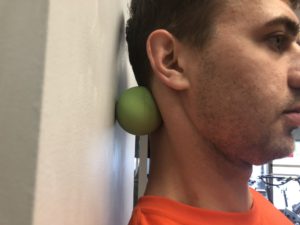By Ryan Parr, B.S. Business Administration, NASM – Certified Personal Trainer and Corrective Exercise Specialist, CHEK Institute – Integrated Movement Specialist
Most of us have a particular postural distortion called “Upper Cross Syndrome” or we are at least fighting against it due to our environments. This distortion can present itself in varying degrees with certain individuals being more prone to a more severe distortion like desk workers, runners, and others that have a forward orientation due to their work or the recreational activities they participate in. It’s important to note that not everyone experiences pain while simply being in this upper cross syndrome posture, but there is a correlation to injury and excessive wear and tear while exercising/moving in this posture.
Upper cross is commonly a combination of a forward head carriage and kyphotic (rounded) mid-spine that typically present together and influence each other. You can notice this in your posture by taking a relaxed side view picture and looking to see if your shoulders and head are forward compared to your ankle, knee, and hip. This imbalance tells us that you are likely to have tight pectorals and neck extensors along with lengthened rhomboids, middle/lower trapezius, and deep cervical flexors. Understanding the length tension relationship of the muscles in the area is important but it is also relevant to understand how the nervous system controls these muscles and its effect on your movement.
An important factor to understand when trying to address this postural distortion is that the pelvis plays a huge role in the position of the upper body. You can test this for yourself by standing up and tilting your tailbone down towards the ground (decreasing the curve in your lower spine), then tilting your tailbone up towards the ceiling (increasing the curve in your back). You should notice that when you tuck your tailbone down that it shifts the weight in your feet towards your heels and that your shoulders/head naturally want to go forward. The exact opposite should be true of tilting your tailbone up. If you have a posteriorly rotated pelvis (tailbone tilted down) it is important to correct this imbalance to deal with a potential root issue to your upper cross syndrome. I have personally seen clients make significant changes in upper body position and reduced pain just through working on correcting the posture down at the pelvis.
Another factor to understand is that over time the cervical spine (neck) will start to straighten causing excessive pressure into different areas of the cervical spine. The cervical spine normally has a curvature in it that allows it to absorb pressure and keep the head in proper position as it relates to your eyesight. This means not only do you need to strengthen the deep cervical flexors in the neck but will also need to reteach your neck extension motor program otherwise you will be fighting an uphill battle. We were designed to keep our eyes at the level of the horizon so our natural instinct of where is ‘right’ to gaze with our eyes will override the work that you do in the gym trying to train/stiffen the muscles that flex the neck. Having a forward head position and keeping your eyes level with the horizon can be a big reason why this distortion can be tricky to improve. You can also imagine how looking at a screen that is above or below your normal eye line could cause a distortion in the neck.
To correct this distortion I recommend taking relaxed static posture pictures of yourself from a side view. First, identify where you are now. After you have this baseline photo it’s important to think about proper positioning through the day, especially in regards to repetitive tasks and the ergonomics of your workspace. Without becoming conscious of your body’s position in space throughout the day, you can run into hurdles trying to improve your distortion. From here it is very important to introduce a corrective exercise routine that will reduce specific tension in the tight muscles, re-establish proper tension through the lengthened musculature, and re-educate the nervous system so the changes in the tissue length and strength actually stick for the long term. The final factor to consider is how your exercise routine and recreational activities impact your posture. Including more exercises that develop strength to keep your upper spine erect and being mindful of you body positioning while exercise can give you a great advantage in improving your fitness while simultaneously improving your posture.
Recommended Corrective Exercise Routine:
Myofascial Release – Pecs and Neck Extensors – Hold with pressure on the trigger point for 1-3 minutes.
Supine Neck Extension with Eye Gaze – 10 reps – While breathing through the nose let your head follow your eyes as you look up to the sky and then down toward the ground. This is the same thing an infant does to develop the curvature in their lumbar and cervical spine for eventual upright posture.
Lewitt Technique – 10 reps – Use a mirror to keep proper position of head while stretching thought the facial lines of the arms/shoulder/neck and re-educating the nervous system.
Wall Retraction – Hold 2 minutes – Tongue on the roof of the mouth can help with the activation of the deep cervical flexors!
We encourage you to talk to your trainer if you think you may have upper cross syndrome and these exercises could benefit you! Working on corrective postural exercise is after all one of our favorite things.


